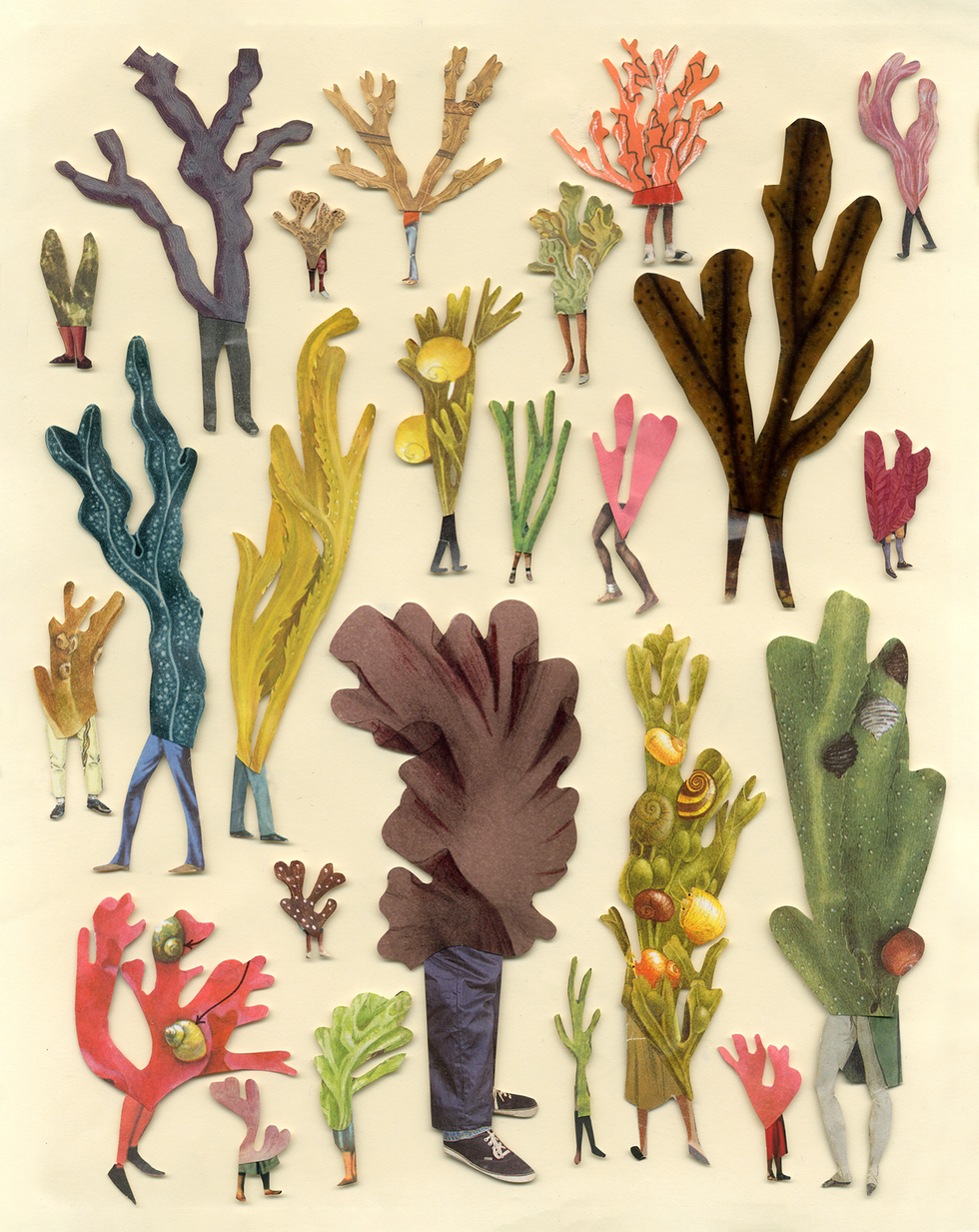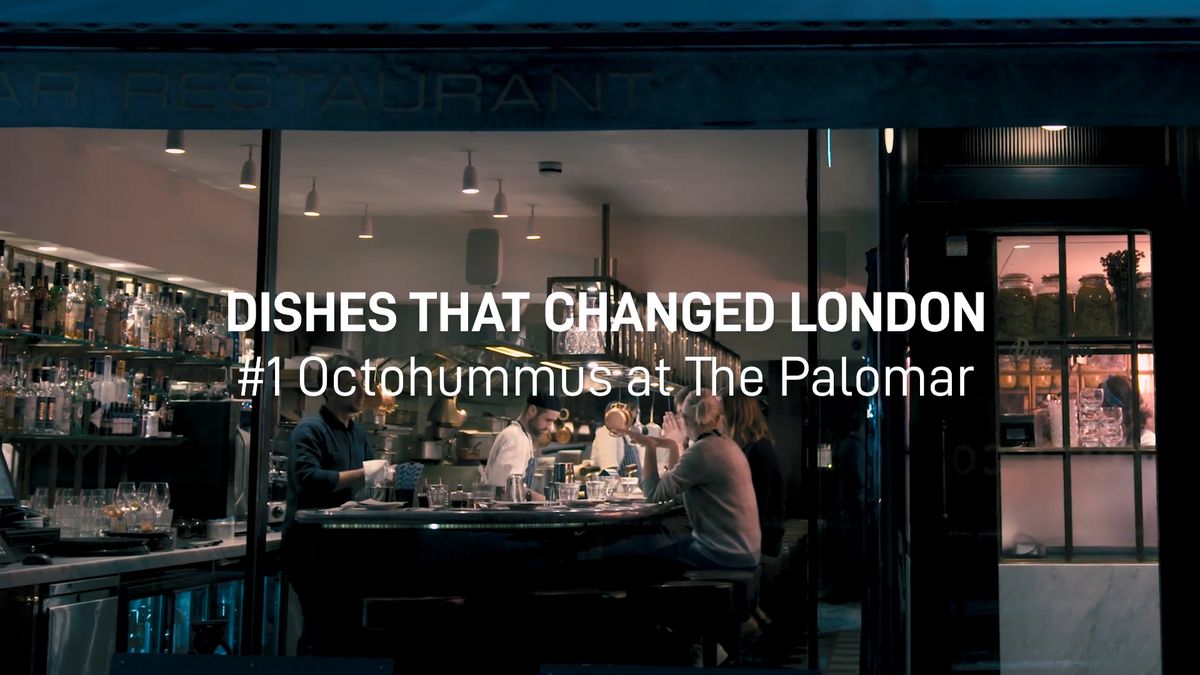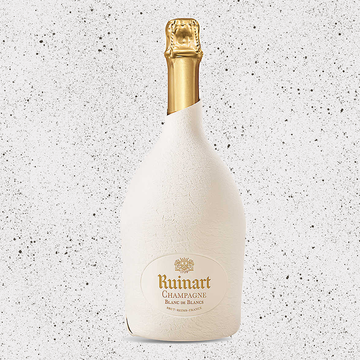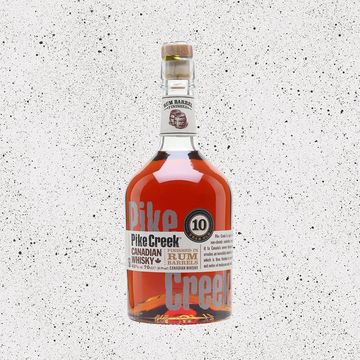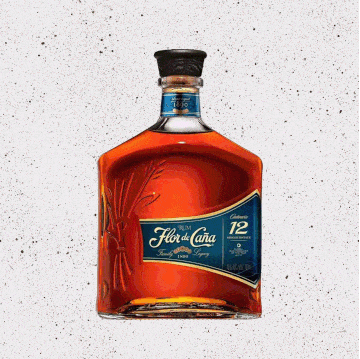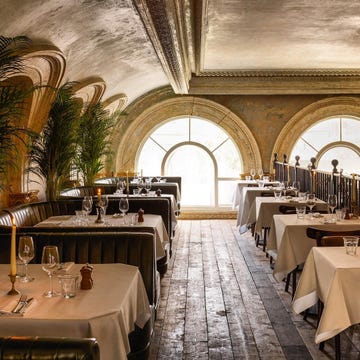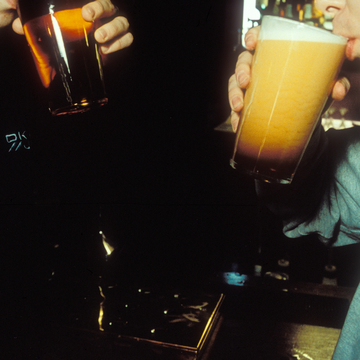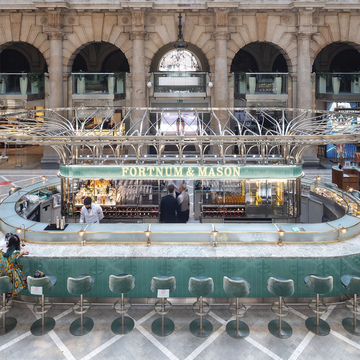In the centre of Swansea’s indoor market there are great piles of ink-black sludge that resemble a petrochemical waste product. This is, in my opinion, the high point of Welsh cuisine. It says a lot about our nation that, while the Japanese took the same seaweed and created paper-thin sheets of nori — sponge-pressed and fan-dried, so delicate it can be lifted by a gust of wind — we took that ingredient, boiled it for days, minced it and portioned it out in polystyrene tubs. And yet I believe that, in its simplicity — and despite its confusing name — laverbread is the perfect expression of seaweed: a blast of pure low-tide, estuarine and refreshing, the culinary equivalent of a winter swim. My sister and I have spent many years wondering why nobody outside Wales feels the same. Why don’t the swanky delicatessens of Highgate and Stockbridge sell tins of Welshman’s Caviar alongside the XO sauce and Vinho Verde? Why does nobody have National Laverbread Day marked in their diaries? (It’s the 14 April; go ahead and set a reminder.) And why is it that — even when it does appear on the menus of upmarket restaurants, as in the “laverbread porridge” at Brat in London — it is never served in its pure and best form, as a straight-up dollop of Instagram-repelling muck, spread on toast with a squeeze of lemon, ugly as hell and umami incarnate?
My sister and I had the idea that we would be the ones to introduce it to the world, become seaweed millionaires. We thought of a name —Mr Laver Laver — and had a plan to blast sunshine reggae from a food truck while serving crab and seaweed brioche rolls at street-food markets. We developed a full menu, did some taste-testing, bought the website. We imagined we would ride the rising enthusiasm for “wild food”. This was back in the early 2010s when Noma in Copenhagen was consistently voted the best restaurant in the world, winning three Michelin stars while serving local mosses, sea buckthorn and forest onions. Suddenly it seemed that all our foodie friends were making their own wild garlic pesto or getting up at dawn to harvest elderflowers. We knew that, if we wanted to be true laverbread connoisseurs, we would need to really understand our star ingredient — and that was what brought us to a beach on the Gower Peninsula at the lowest tide of the year.
As we walked down towards the tideline, the sea retreated ahead of us. It was receding at such speed that we wondered if it might just keep going, empty out the whole Bristol Channel. It felt almost indecent, like we were seeing the beach’s private parts, the patches of petrified forest and warty mussel beds that only saw sunlight on this one day of the year. And when we finally got down to the edge of the water, that’s where we met them: the coastal foragers. Strange, tidal people who keep the full moon circled in their calendars. I knew that these people were also, in a sense, outlaws, since legally you need a licence from the Crown Estate to forage the King’s own clams and — although I didn’t ask to see their paperwork —I had a feeling that no such licences had been granted.
We watched two men with long, hooked poles scrabble about for lobsters and crabs in the once-a-year rock pools. A friendly couple filled Tupperware with whelks and cockles. A man with a bucket and a tub of table salt was doing a slow moonwalk along the tideline, occasionally kneeling down to squirt a sports-lid water bottle into keyhole-shaped holes in the sand. His bucket was empty and he seemed a little insane. But hours later, we saw him again, his hands full of large razor clams. He explained that, with his backward footsteps and his salt water, he was being a one-man ocean, tricking the clams into believing that the tide was returning so they would stick their unsuspecting limb into the air — and that’s when he plucked them out. Already I wanted to be among this secret club. I wanted to be the kind of person who keeps a hard copy of the tide timetable in their shirt pocket.
My sister and I started filling a Sainsbury’s bag with laver. This particular brownish seaweed, delicate and semi-transparent, lay flat across the rocks like a bad combover. Once we’d got a fair few handfuls, we took it home to our parents’ house in the nearby village and washed it in their outdoor sink. It felt as though we were shampooing a sea monster, watching the dozens of tiny sea creatures — shrimps, sand hoppers, tiny transparent crabs — emerge from the strands and scuttle away towards the beach. Then we boiled the seaweed for 24 hours on my parents’ tiny electric hob. Slowly the house filled with a smell like low tide on a hot day. My mother prowled through her low-ceilinged kitchen, sniffing the air and fuming. Finally, we drained it, whizzed it with a stick blender, cooked it down, seasoned it relentlessly and, eventually, had a large bowl’s worth of the good stuff, our future careers glistening before us: black gold.
In truth, our creation wasn’t nearly as tasty as what we could buy in Swansea Market’s famous “cockle rotunda”. Our product was insufficiently unctuous and we could feel grains of sand catching in our teeth. This was not surprising, given that the local firms, Selwyn’s and Parsons, have been harvesting and preparing laverbread for generations and, beyond that, the Welsh have been perfecting the art for hundreds, even thousands, of years. It is called “bread” because of the way that the original laver-pickers used to knead the seaweed, working it into loaf-like mounds. We thought the simple fact of our Welshness would give us the necessary skills, but it seemed like there was maybe a tad more expertise involved. Still, this was our first attempt and, years from now, when we were poolside in our villas bought with our seaweed money, we would look back fondly on our early incompetence. I put the leftover laverbread in my mum’s freezer and, in my diary, marked the next perigean tide, a word I had just learned from a book on coastal foraging. I knew my perigee from my neap, my foreshore from my sub-tidal zone, and I liked to use the terms as much as possible.
Months later, though, I came home to find that my mother, unimpressed by the whole idea — and wanting to make space for soup in her freezer —had thrown all our hard work, our hopes and dreams, onto the compost. This was the first review of our laverbread and it was a hatchet job. In fact, it was so disheartening that my sister and I never again summoned the same enthusiasm for Mr Laver Laver. We had envisioned our parents’ garage as the research and development arm of our business and, without their support, it was hard to see a way forward. Over time, we stopped discussing seaweed and, eventually, let the website lapse. Another broken dream to add to the collection. And yet, I still found myself thinking about how much I’d enjoyed being among the foragers at low tide, this society of weirdos who grip handfuls of red and green seaweed in the same way a cheerleader holds their pompoms. And so — freed from a desire to make life-changing amounts of money — I returned to the coast with more pretentious motives.
At the next low tide, my five-year-old son and I traipsed up and down Oxwich Bay with a bottle of water and some table salt, trying and failing to become the sea. Luckily for us, a friendly Welsh-Chinese lady — her bucket brimming — took pity on us and gave us one of her razor clams. The result was that — after a whole day’s hunting, our necks slowly turning the pink of the lobsters we would definitely never catch — we took our prize home and cooked it, a single clam, roasted on the barbecue and portioned between six. It was glorious. After that, we decided to hunt only creatures that could not hide from us: whelks and cockles. We brought home enough cockles for everyone to have five each. (For comparison, Selwyn’s of North Gower cooks and processes thousands every day, the vast majority of which are immediately shipped to restaurants and fish markets all over Spain.) The whelks we cooked in garlic butter before realising we didn’t have the right implements to winkle — or whelk — them from their shells. We sat at the dining table, listening to each other’s grunting sounds as we tried and failed to scoop out the tiny comma of bivalve. It was obvious that whatever calorific content the whelks might provide would not cover the energy expended in trying to eat them. As this point, I glanced up to see my mother looking at me with an expression I knew well. Why, she seemed to say, are you doing this? Who are you pretending to be? I told myself that she did not understand my profound and abiding connection to the natural world.
From then on, I changed from coastal to inland pursuits, away from my mother’s doubting gaze. I signed up for a mushroom-foraging course with a man, Andy Overall, who goes by the name of Fungi To Be With. Back in the 1980s, he was known as Andy O and was the singer in a new wave band. Strangely it doesn’t seem that big a leap from doing vocals for BlueZoo to becoming one of the country’s leading mycologists. He was clearly a man of niche subcultures, from synth-pop to spore prints. He led us through the backwoods of Hampstead Heath and we found an array of mushrooms and fungi: ink caps, penny buns, amethyst deceivers and boletes. I say we found them but what I really mean is that he found them, showed them to us, then let us pick them.
Once I had this new hobby, every countryside walk was hijacked as a foraging trip. On an autumn walk through Epping Forest, I was forever getting out the app on my phone — the Fungitron Mushroom Guide. My wife found this initially interesting and quickly not. “I’m pretty sure this is a golden chanterelle,” I said, kneeling in a dingy copse. I picked it and packed it into the flax linen pouch that I had bought for this very purpose and then spent the rest of the walk talking about how lucky we were. Only when we got home and laid the mushroom on the chopping board did I finally concede that it may have been in fact a darker orange Jack O’Lantern mushroom, the chanterelle’s toxic lookalike, known for its bioluminescence and the way that, when eaten, it causes vomiting, diarrhoea and severe cramps. I learned that nothing kills the appetite like a list of potential symptoms.
Despite my lack of success, I proceeded to become a mushroom bore, a fun guy to be without. A hobby that was supposed to connect me with the natural world had become weirdly alienating as forest walks became a self-important version of Pokémon Go, with me rushing off into the bushes with my phone out. For my birthday, I requested some fungal “plug spawn” so that I could grow my own edible chicken of the woods mushrooms in
our shared back garden. I impregnated a wedge of rotting oak with the spore plugs and carried it out to the dankest part of our garden, the bushy bit at the back where we’d seen the urban foxes having violent sex, howling and biting each other for 30 long minutes, locked together by the male’s barbed genitals. It was perhaps fortunate that we moved house long before my mushrooms started fruiting. We never had to answer the question of whether we would actually wish to eat mushrooms that had grown in those conditions.
The strange thing about all this was that — although I talked a good forage— I’d never been brave enough to eat any of the mushrooms I’d picked. I clearly wanted to be a woodsman, the kind of person who could survive in the wild, but my personality kept getting in the way. One of the phrases from my mushroom book was “if in doubt, throw it out” and — since I couldn’t imagine feeling certain about anything in my life, least of all a mushroom that might potentially cause lethal liver failure in my entire family — I always threw it out.
Things came to a head when I was visiting my parents in South Wales. While we were out walking, I found, at the side of the path, a large and handsome shaggy ink cap. These slender white mushrooms are one of the so-called “foolproof four” — easy to recognise and safe to pick. I’d never seen one before. It was about the size and shape of a karaoke microphone. And while my mother immediately said “don’t even touch it”, I held my nerve and tugged it out from the root. I was gratified when, moments later, some passing hikers confirmed that, firstly, it was edible and, secondly, they were jealous. “If you don’t eat it, we will,” they said. For the only time in my mycological career, I felt not even a tickle of doubt. My time had come. I carried the shaggy ink cap home proudly, in one hand, teasing my mother by pretending to lick it like an ice cream. Then I put it in the fridge and started making plans for the next day’s glorious foraged breakfast.
What I had forgotten, of course, was that the shaggy ink cap is incredibly short-lived. You have to cook it within hours of picking so that, when I opened the fridge in the morning, it was already starting to deliquesce. As I stared down at the growing pool of pungent black slime, I could feel my mother behind me, a look of victory on her face. Soon, all that was left of the mushroom was a plate of black ink that my children used to paint some rather gothic and foul-smelling pictures. We left the artworks to dry on the garden table and found that they quickly become the site of an insectoid orgy, swarming with slugs and snails and unnamed weevils and beetles, all feasting on my children’s creativity. And that was the moment I finally accepted that foraging probably wasn’t for me.
The truth is that, like many people, I long to feel at one with nature but am held back by what nature is actually like. I do try to tell my children, for example, that spiders are our friends. They catch flies and mosquitoes and, in turn, protect us from disease, I say. But even as I am speaking, a part of me is always inwardly screaming about how spiders bind their prey in silk, inject them with poison, wait for them to die, then vomit digestive fluids onto their victim before sucking out the innards like water from a coconut. That’s not the kind of friend I want. And, similarly, my desire to forage my own food hides a deeper truth about myself: that I am indoorsy, urbanised, detached from my animal self, and would definitely die first in the event of societal collapse. And when I finally came to accept this, it was, after all, a huge relief.
That I gave up on foraging was also, I learned, probably good news for the natural world. In 2015, Epping Forest banned foraging altogether since too many amateur foodies from London were picking every mushroom they could find, disrupting the local habitat while also, sometimes — ahem —not even eating what they picked. Since then, other Wildlife Trusts around the UK have followed suit. Meanwhile, a quick browse through #foragingon Instagram will confirm that wild food can swerve dangerously close to a wellness trend. Good-looking people fill rattan baskets with chanterelles, only interrupting their profound communion with the seasons in order to post about it.
I was fortunate, then, that as part of the research for this article my editor sent me on an assignment well suited to an ex-forager. I put on a nice shirt and caught the Victoria line into central London, a journey in which my eyes took in nothing natural, only concrete and infrastructure and scrolling video adverts for hair replacement therapy. In the subterranean private dining room of an upscale restaurant in Marylebone, I sat down to experience the latest creations from Noma Projects, an offshoot of the restaurant in Copenhagen. In the safety of the low lit room, I watched the chefs tweezer out plates of lobster, squid and scallop ceviche which came with — I noted with excitement — foraged Welsh seaweed. After tasting this delicate, fragrant dish I can confirm it was a long way from the Tupperware of gritty black sludge that my mother had thrown on the compost heap. Other highlights from the British coastline included samphire and salty-fingers, which resembled little plump jelly babies. What I really loved about all these ingredients is that they had been hand-picked from the wild by someone who wasn’t me. At the end of the meal, they gave each journalist a tote bag containing five pots of exquisite seasonal condiments, all of which are available by mail order. This was the kind of foraging I could get behind.
So now, when I feel the urge to reconnect with the undergrowth, I simply shake up the jar of Forager’s Vinaigrette. It contains blackcurrant wood oil and fragrant wild rose petals, collected from the Danish beaches.I splash it onto my bagged mixed salad leaves then close my eyes and, like that, I am transported. I am of the earth. The tides live within me. And then, with ceremony, I put the jar back in the fridge. ○
Illustrations: bengilesart2



